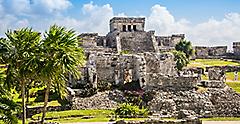But one of the country's most vibrant facets is its rich culture, which brims with unique traditions and beliefs. This includes the fascinating Mexico myths and legends that surround local sites, such as the cenotes tucked away in the wilderness near the ruins of Maya cities and charming towns like Guanajuato, where star-crossed lovers established a tradition that lives on.


The Romantic Myth Of Kissing Alley — Guanajuato, Mexico
There's a city in central Mexico that's known for its colonial architecture and its history of mining silver. Its alleyways are extremely narrow, and its balconies are sometimes close enough for two people to lean across and hold hands or share a kiss.
According to legend, this is what happened in the city's famous Callejon del Beso, the Alley of the Kiss. Though it's a tragic tale, this is one of the more romantic myths of Mexico. The story goes like this: Long ago in Guanajuato, a man engaged his beautiful daughter, Carmen, to a rich Spanish man in order to grow his own fortune. However, while she was attending church, Carmen met a handsome, hardworking miner named Don Luis, and the two fell deeply in love. They saw each other in secret until Carmen's father discovered them and threatened to send Carmen to a convent unless she stopped seeing Don Luis.

The story takes a darker turn here. One day, the couple met on their balconies and swore their eternal love. Carmen's father happened to enter her bedroom at this exact moment. Filled with rage about his daughter's defiance, he thrust a dagger into her back as Don Luis kissed her hand across the alley. Don Luis passed away shortly afterward, his heartache too much to bear.
Based on this legend, superstition dictates that all couples who visit the Kissing Alley must share a kiss over it — otherwise, they'll have seven years of bad luck.

Mexico Myths On What Mayans Believe About Cenotes — Peninsula Yucatán
Popular with both local sea life and cruise travelers, Mexico's Yucatán Peninsula is peppered with cenotes nestled along the coastline and deep within emerald green jungles. There are thousands of these spectacular freshwater lagoons, some of them tucked away in caves and undisturbed for centuries. The more accessible cenotes have lured travelers with their still, crystal-clear waters and quiet tranquility, but these natural wonders have also played a big role in Mexico myths and legends dating all the way back to ancient times.
Cenotes were a crucial fixture of daily life for the ancient civilizations that flourished in the Yucatán. Since this region has no rivers or lakes, cenotes gave ancient peoples access to fresh water year-round. The word "cenote" itself comes from the Yucatec Mayan word "dzonot," which means "well." In fact, all the biggest Maya civilizations from 300 CE to 900 CE sprang up around cenotes. To give you an idea of just how vital cenotes were to ancient peoples, the city of Mayapan leveraged 40 cenotes to supply water to as many as 17,000 inhabitants.
Because they relied so heavily on these freshwater wells, the Maya developed strong beliefs and myths around them. They believed cenotes doubled as gateways to Xibalba, the underworld, and that the rain god, Chaac, lived at the bottom of cenotes. It's why they performed elaborate ceremonies and rituals at cenotes to ask for good crops and rain.
One of the most iconic cenotes in Mexico is the Sacred Cenote. It's located close to the ancient Maya city of Chichen Itza — a popular stop for travelers visiting the region. Gold and jade artifacts have been found here, as well as pottery. And while cenote ceremonies may be a practice of the past, some Maya descendants still pay their respects to the gods and mythical beings they believe dwell there.
Mayan Legend Of The Hummingbird — Yucatán Peninsula
Here's another fascinating Mexican myth. Like the legends surrounding the Yucatán's cenotes, it comes from ancient Mayan culture.
The legend goes that when the Maya gods created Earth, they gave each tree, rock, and animal a special task. Once they'd delegated all tasks to all the creatures they'd carefully crafted from mud and corn, the gods realized they'd forgotten to assign the most significant mission of all: carrying wishes.
Thinking quickly, they carved a small jade stone into an arrow and breathed life into it. It transformed into a tiny, fluttering bird whose feathers caught the light and shimmered as they beat. Today, this beautiful creature is known as the hummingbird. From the moment it came to life, the hummingbird took up its task and fulfilled it honorably, flitting from place to place with dreams, hopes, and wishes in tow.
This ancient Maya legend has persisted through the ages, and while it's taken on new forms and dimensions over time, the core story has remained the same. To this day, people throughout the Yucatán Peninsula believe that if a hummingbird flies over your head, it is collecting your wish and carrying it on so that it may come true. Keep an eye out for these tiny birds on your trip — you never know what may happen!
Mexico Legends & Facts From Coast To Coast

Get Royal Deals, Sign Up Today












